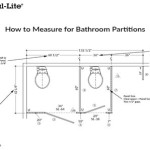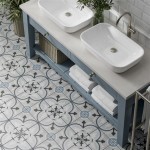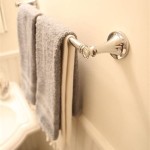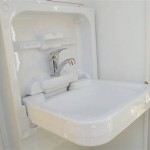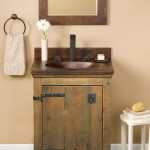How To Install Backsplash On Bathroom Vanity
Installing a backsplash on a bathroom vanity is a practical and aesthetic improvement that can significantly enhance the look and functionality of the space. A backsplash protects the wall from water damage, soap scum, and other common bathroom messes. It also adds a decorative element that can complement the vanity, countertop, and overall bathroom design. This article will provide a comprehensive guide on how to install a backsplash on a bathroom vanity, covering the necessary tools, materials, preparation steps, and installation techniques.
Assessing The Project and Gathering Materials
Before beginning the installation process, it is crucial to assess the scope of the project and gather all the necessary materials and tools. This initial step ensures a smooth and efficient workflow and minimizes the chances of encountering unexpected delays. First, measure the area behind the vanity where the backsplash will be installed. Determine the length and height of the backsplash needed, and add a small amount of extra material (approximately 10%) to account for cuts and potential errors. Common backsplash heights range from 4 to 6 inches, but the optimal height depends on the vanity size and personal preference.
Next, select the backsplash material. Popular choices include tile (ceramic, porcelain, glass, or natural stone), peel-and-stick tiles, and pre-fabricated backsplash panels. Tile offers a wide range of design options and is durable and water-resistant. Peel-and-stick tiles are easy to install and suitable for DIY projects. Pre-fabricated panels provide a seamless look and require minimal cutting. Consider the overall aesthetic of the bathroom and the desired level of maintenance when choosing the material.
The following is a list of necessary materials and tools:
- Backsplash material (tiles, panels, or peel-and-stick tiles)
- Tile adhesive (thin-set mortar for tile, construction adhesive for panels)
- Grout (for tile installations)
- Grout sealant (for tile installations)
- Caulk (silicone caulk)
- Measuring tape
- Pencil
- Level
- Tile cutter (snap cutter or wet saw for tile)
- Notched trowel (for tile installations)
- Grout float (for tile installations)
- Grout sponge (for tile installations)
- Caulk gun
- Utility knife
- Safety glasses
- Gloves
- Drop cloth or plastic sheeting
- Painter's tape
- Sandpaper (optional, for smoothing rough surfaces)
Ensure that all materials are compatible with the chosen backsplash material and that the adhesive and grout are suitable for bathroom environments.
Preparing The Surface
Proper surface preparation is essential for a successful backsplash installation. A clean, smooth, and stable surface ensures optimal adhesion and prevents future issues such as cracking or peeling. Begin by cleaning the wall behind the vanity. Remove any existing wallpaper, paint flakes, or debris. Use a mild detergent and water to scrub the surface, and rinse thoroughly. Allow the wall to dry completely before proceeding.
Inspect the wall for any imperfections, such as holes or cracks. Fill small holes with spackle or joint compound and allow it to dry. Sand the patched areas smooth with fine-grit sandpaper. For larger cracks or damaged areas, consult a professional to ensure structural integrity. If the existing wall surface is glossy or non-porous, lightly sand it with medium-grit sandpaper to create a slightly rough surface. This will improve the adhesion of the adhesive.
Use a level to check the wall for any unevenness. If the wall is significantly out of plumb, shimming the backsplash material may be necessary to achieve a level and professional-looking finish. Consider applying a primer to the wall before installing the backsplash. Primer enhances adhesion, seals the surface, and provides a uniform base for the adhesive. Choose a primer that is compatible with the chosen adhesive and backsplash material. Apply the primer according to the manufacturer's instructions and allow it to dry completely.
Protect the vanity countertop and surrounding areas by covering them with drop cloths or plastic sheeting. Secure the edges with painter's tape to prevent any spills or splatters from damaging the surfaces.
Installing The Backsplash
With the surface properly prepared and materials gathered, the actual installation of the backsplash can begin. This step requires precision and attention to detail to ensure a professional and aesthetically pleasing result. Depending on the type of backsplash material chosen (tile, panel, or peel-and-stick), the installation process will vary slightly.
Tile Installation:
For tile installations, begin by mixing the thin-set mortar according to the manufacturer's instructions. Use a notched trowel to apply a thin, even layer of mortar to the wall, covering a small section at a time. The size of the notched trowel will depend on the size and type of tile being used. Generally, a ¼-inch notched trowel is suitable for most standard-sized tiles. Press the tiles firmly into the mortar, ensuring that they are level and aligned. Use tile spacers to maintain consistent grout lines between the tiles. Periodically check the level of the tiles with a level to ensure they are properly aligned.
When cutting tiles to fit around outlets, pipes, or corners, use a tile cutter or wet saw. Measure the required cut carefully and mark the tile with a pencil. Use a snap cutter for straight cuts and a wet saw for more intricate shapes. After cutting, smooth the edges of the tile with a tile file or sandpaper. Continue installing tiles until the entire backsplash area is covered. Allow the mortar to dry completely according to the manufacturer's instructions (typically 24-48 hours).
Once the mortar is dry, remove the tile spacers and prepare the grout. Mix the grout according to the manufacturer's instructions. Use a grout float to apply the grout to the tile joints, pressing it firmly into the spaces. Remove excess grout from the tile surface with the grout float. Allow the grout to set for a few minutes, then use a damp grout sponge to wipe away the remaining grout residue. Rinse the sponge frequently to avoid smearing the grout across the tile surface. Allow the grout to cure completely according to the manufacturer's instructions (typically 24-72 hours). Apply a grout sealant to protect the grout from moisture and stains.
Panel Installation:
For pre-fabricated backsplash panels, apply construction adhesive to the back of the panel according to the manufacturer's instructions. Position the panel against the wall and press it firmly into place. Use a level to ensure that the panel is straight and aligned. If necessary, use shims to maintain a level surface. Secure the panel with painter's tape to hold it in place while the adhesive dries. Allow the adhesive to dry completely according to the manufacturer's instructions (typically 24-48 hours).
If the panel requires cutting to fit the space, use a utility knife or saw to trim it to the desired size. Measure the required cut carefully and mark the panel with a pencil. After cutting, smooth the edges of the panel with sandpaper. Apply caulk along the edges of the panel where it meets the countertop and wall. This will create a waterproof seal and prevent water from penetrating behind the panel.
Peel-and-Stick Tile Installation:
For peel-and-stick tiles, ensure that the wall surface is clean, dry, and smooth. Peel off the backing from the tile and carefully position it against the wall. Press the tile firmly into place, ensuring that it is aligned with the adjacent tiles. Use a level to check the alignment. If necessary, peel the tile off and reposition it before firmly pressing it into place. Cut the tiles to fit around outlets, pipes, or corners using a utility knife or scissors. Measure the required cut carefully and mark the tile with a pencil. After cutting, smooth the edges of the tile with sandpaper.
Overlap the tiles slightly to create a seamless look. Press the overlapping edges firmly together to ensure a strong bond. Apply caulk along the edges of the backsplash where it meets the countertop and wall. This will create a waterproof seal and prevent water from penetrating behind the tiles.
Finishing Touches
After the backsplash has been installed and the adhesive or grout has cured, the final step is to apply caulk to seal the edges and create a waterproof barrier. Use a caulk gun to apply a bead of silicone caulk along the edges of the backsplash where it meets the countertop and wall. Smooth the caulk with a wet finger or a caulk smoothing tool to create a clean, professional-looking finish. Wipe away any excess caulk with a damp cloth.
Inspect the backsplash for any imperfections or gaps. Fill any small gaps with caulk or grout. Clean the backsplash with a mild detergent and water to remove any dust or residue. Polish the surface with a clean, dry cloth to enhance its shine. Remove the painter's tape and clean up any debris or spills. Dispose of all waste materials properly.
Key Considerations
Safety First: Always wear safety glasses and gloves when working with tools and materials. Follow the manufacturer's instructions for all adhesives, grouts, and sealants. Ensure adequate ventilation when working with adhesives and sealants.
Accurate Measurements: Take accurate measurements of the backsplash area and cut the materials accordingly. Double-check all measurements before cutting to avoid errors.
Proper Application: Apply adhesives and grouts evenly and according to the manufacturer's instructions. Use the correct tools and techniques for each material. Ensure that the backsplash is level and aligned.
By following these detailed instructions and paying attention to the key considerations, anyone can successfully install a backsplash on a bathroom vanity. This improvement will enhance the visual appeal and functionality of the bathroom.

How To Install A Tile Backsplash

Updating A Vanity With Custom Tile Backsplash The Kim Six Fix

Small Bathroom Remodel Easy Diy Tile Backsplash Engineer Your Space

How To Install Backsplash Bathroom Tile Easy Simple

Tutorial How To Install A Bathroom Vanity The Diy Playbook

Brilliant Bathroom Backsplash Ideas Family Handyman

A Bathroom Backsplash Is It Worth Installing On Your Vanity

Removable Tile Backsplash For Bathroom Vanity

Small Bathroom Remodel Easy Diy Tile Backsplash Engineer Your Space

Do You Need A Backsplash For Your Bathroom Vanity Diamond Kitchen Bath
Related Posts
